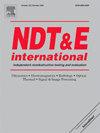Advanced real-time rail monitoring system based on directional eddy current probe
IF 4.5
2区 材料科学
Q1 MATERIALS SCIENCE, CHARACTERIZATION & TESTING
引用次数: 0
Abstract
Increased train speeds and freight loads have contributed to the development of Rolling Contact Fatigue (RCF) and localized damage, such as studs and squats, at wheel-rail contact points. If left undetected, these defects can progress into shelling, where fluid penetration into fatigue cracks accelerates crack propagation and material separation or rail breaks. To address this issue and preserve rail integrity, a non-contact, high-speed, real-time directional eddy current probe for defect inspection has been developed. Initial laboratory testing of the portable prototype, conducted with studs exhibiting RCF-type defects, demonstrated successful detection at increasing speeds. The obtained eddy current results were further validated by ultrasonic testing (UT) to determine the depth profile. Finally, the signal-to-noise ratio (SNR) of the proposed system was estimated for a quantitative evaluation of inspection performance. Subsequent field tests were performed by integrating the technology with a Geismar TC Track Screwdriver on a section of R50 rail on track in the Almaty region of southern Kazakhstan. The system effectively identified spalling, indentations, and shelling defects, with a signal-to-noise ratio exceeding 4.5, showcasing its potential for reliable rail-defect inspection.
基于定向涡流探头的先进轨道实时监测系统
列车速度和货物负荷的增加导致了滚动接触疲劳(RCF)的发展和轮轨接触点的局部损伤,如螺栓和凹陷。如果不及时发现,这些缺陷可能会发展成脱壳,这时流体进入疲劳裂纹会加速裂纹扩展,导致材料分离或钢轨断裂。为了解决这一问题并保持钢轨的完整性,一种用于缺陷检测的非接触、高速、实时定向涡流探头被开发出来。对便携式样机进行的初步实验室测试显示,螺柱存在rcf型缺陷,测试结果表明,检测速度越来越快。通过超声检测(UT)进一步验证了得到的涡流结果,确定了深度剖面。最后,估计了系统的信噪比(SNR),对检测性能进行了定量评价。随后,在哈萨克斯坦南部阿拉木图地区的一段R50轨道上,将该技术与Geismar TC轨道螺丝刀结合起来进行了现场测试。该系统有效地识别了剥落、压痕和脱壳缺陷,信噪比超过4.5,显示了其可靠的轨道缺陷检测潜力。
本文章由计算机程序翻译,如有差异,请以英文原文为准。
求助全文
约1分钟内获得全文
求助全文
来源期刊

Ndt & E International
工程技术-材料科学:表征与测试
CiteScore
7.20
自引率
9.50%
发文量
121
审稿时长
55 days
期刊介绍:
NDT&E international publishes peer-reviewed results of original research and development in all categories of the fields of nondestructive testing and evaluation including ultrasonics, electromagnetics, radiography, optical and thermal methods. In addition to traditional NDE topics, the emerging technology area of inspection of civil structures and materials is also emphasized. The journal publishes original papers on research and development of new inspection techniques and methods, as well as on novel and innovative applications of established methods. Papers on NDE sensors and their applications both for inspection and process control, as well as papers describing novel NDE systems for structural health monitoring and their performance in industrial settings are also considered. Other regular features include international news, new equipment and a calendar of forthcoming worldwide meetings. This journal is listed in Current Contents.
 求助内容:
求助内容: 应助结果提醒方式:
应助结果提醒方式:


